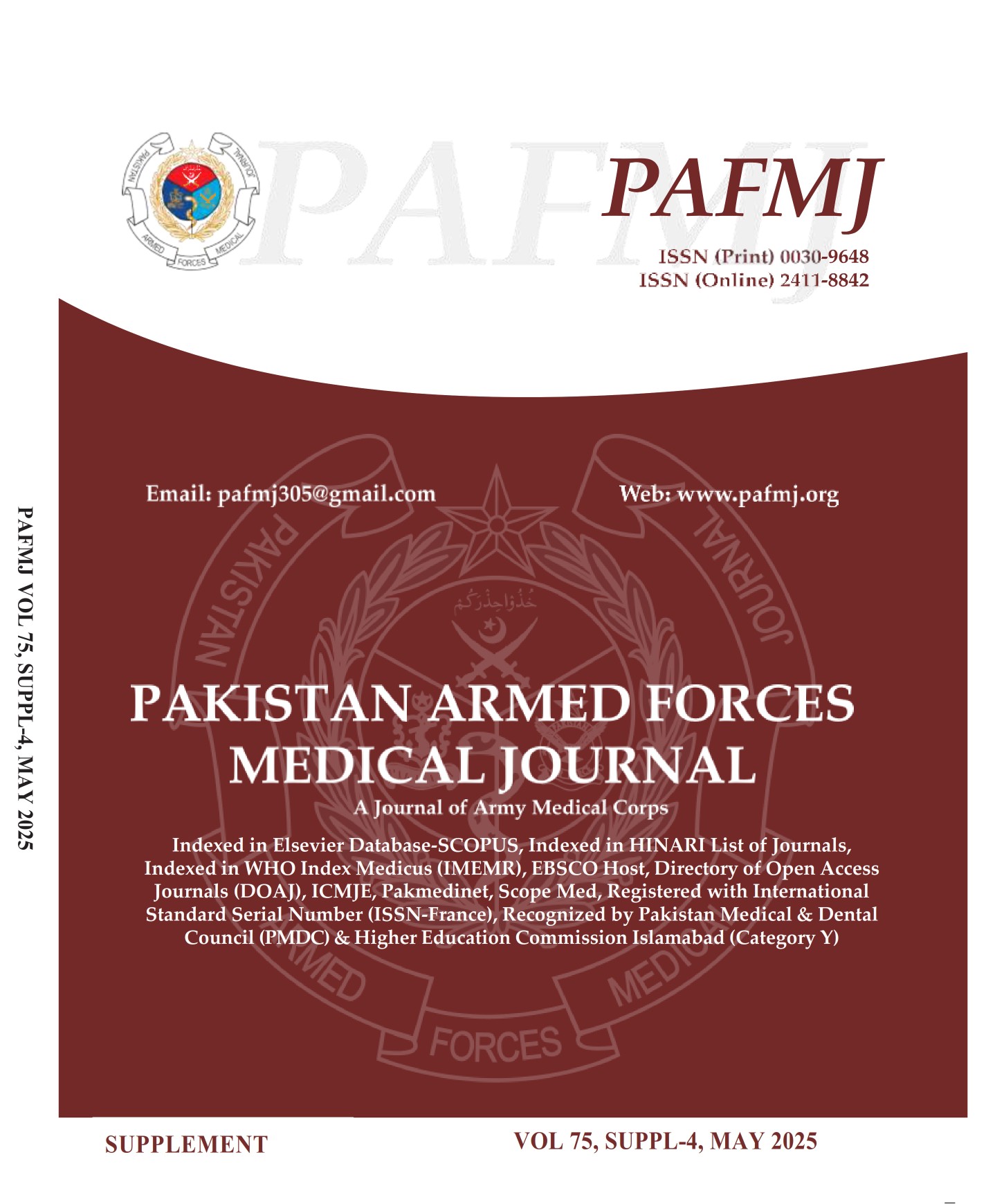Comparison of Endoscopic Laser Assisted Dacryocystorhinostomy with Conventional External Dacryocystorhinostomy Surgery
DOI:
https://doi.org/10.51253/pafmj.v75iSUPPL-4.12429Keywords:
Comparative study, conventional, Dacryocystorhinostomy, Endoscopic, external, laser, Nasolacrimal duct obstruction.Abstract
Objective: To compare the effectiveness and outcomes of endoscopic laser assisted dacryocystorhinostomy (DCR) with conventional external dacryocystorhinostomy (DCR) for symptomatic nasolacrimal duct occlusion (NLDO).
Study Design: Quasi-experimental study.
Place and Duration of Study: Ophthalmology department at Combined Military Hospital, Multan from March 2023 to Feb 2024.
Methodology: 40 participants (n=40) were included in this study through non-probability convenience sampling technique. Twenty participants (n=20) were treated by conventional external DCR surgery (Group A), while the other twenty (n=20) underwent laser endoscopic DCR surgery (Group B). Primary outcomes included overall success rate, defined as absence of symptoms when accompanied by functioning tear drainage system; and secondary outcomes measures which were complication rates, cosmesis and patient satisfaction. Data was collected through preoperative examination as well as postoperative follow-up for up to 3 months.
Results: Among the total 40 patients, 52.5% were male & 47.5% were female. Average age in group A and group B was 47.25± 8.1 years and 46.5±6.8 years respectively. Both Group A and Group B exhibited significant success rates (p=0.543), with lower complication rates in Group B (p=0.217). Additionally, higher patient satisfaction scores were observed in Group B (p=0.659), with comparable cosmesis outcomes between the two groups (p=0.423).
Conclusion: Both endoscopic laser assisted DCR and conventional external DCR were relatively equal in terms of relieving NLDO. However, laser endoscopic DCR offered additional merits which included time saving, low invasiveness, no need for general anesthesia, good cosmetic effect, higher patient satisfaction, lower complication rates and relatively bloodless surgery.
Downloads
References
Hu K, Patel J, Patel BC. Crigler Technique for Congenital Nasolacrimal Duct Obstruction. [Updated 2023 Jul 24]. In: StatPearls [Internet]. Treasure Island (FL): StatPearls Publishing; 2024 Jan-. Available from:
https://www.ncbi.nlm.nih.gov/books/NBK559267
Makselis A, Petroska D, Kadziauskiene A, et al. Acquired nasolacrimal duct obstruction: clinical and histological findings of 275 cases. BMC Ophthalmol 2022; 22: 12.
https://doi.org/10.1186/s12886-021-02185-x
Sobel RK, Aakalu VK, Wladis EJ, Bilyk JR, Yen MT, Mawn LA, et al. A comparison of endonasal dacryocystorhinostomy and external dacryocystorhinostomy: a report by the American Academy of Ophthalmol. 2019; 126(11): 1580-1585.
https://doi.org/10.1016/j.ophtha.2019.06.009
Yakopson VS, Flanagan JC, Ahn D, Luo BP. Dacryocystorhinostomy: History, evolution and future directions. Saudi J Ophthalmol 2011; 25(1): 37-49.
https://doi.org/10.1016/j.sjopt.2010.10.012
Jawaheer L, MacEwen CJ, Anijeet D. Endonasal versus external dacryocystorhinostomy for nasolacrimal duct obstruction. Cochrane Database Syst Rev 2017; 2(2): CD007097.
https://doi.org/10.1002/14651858.CD007097
Somuk BT, Alim S, Sapmaz E, Demir HD, Taşkıran B, Göktaş G, et al. Comparison of endoscopic and external dacryocystorhinostomy results and analysis of patients' satisfaction. Turk Arch Otorhinolaryngol 2016; 54(3): 99-104.
https://doi.org/10.5152/tao.2016.1722
Awais M, Naqvi SAH, Akram A, Shahid M. Transcanalicular diode laser assisted dacryocystorhinostomy: A breakthrough in the treatment of acquired nasolacrimal duct obstruction. Pak J Med Sci 2020; 36(4): 804-807.
https://doi.org/10.12669/pjms.36.4.1906
Ali MJ, editor. Principles and practice of lacrimal surgery. Springer; 2018 Feb 8. https://books.google.co.il/books?id=q0tLDwAAQBAJ&printsec=frontcover&source=gbs_ge_summary_r&cad=0
Faruque S, Badrunnesa A, Saha P, Mafi I, Shafi I, Asaduzzaman M, et al. Prospective comparison of conventional external dacryocystorhinostomy and endonasal laser dacryocystorhinostomy. J Bangladesh Coll Physicians Surg 2024; 42: 355-362.
https://doi.org/10.3329/jbcps.v42i4.76322
Costa JR, Casanova M, Soares T, Almeida C. Comparison of surgical success between two different approaches of the lacrimal pathway, External and Transcanalicular Dacryocistorinostomy, and between two different age groups. Revista Portuguesa de Otorrinolaringologia-Cirurgia de Cabeça e Pescoço 2020; 58(1): 15-21.
https://doi.org/10.34631/sporl.805
Zafar A, Ahmad I, Bashir MM. Prevalence and clinical profile of nasolacrimal duct obstruction in adult patients attending a tertiary care hospital in South Asia. Int J Ophthalmol 2018; 11(6): 1023–1027. https://doi:10.18240/ijo.2018.06.21
Sung JY, Lee YH, Kim KN, Kang TS, Lee SB. Surgical outcomes of endoscopic dacryocystorhinostomy: Analysis of age effect. Sci Rep 2019; 9(1): 56491.
https://doi.org/10.1038/s41598-019-56491-y
Rasaily SB, Pokharel K, Katuwal S, Bishowkarma S, Limbu B, Saiju R et al. External dacryocystorhinostomy and patient satisfaction: Perspective of general ophthalmologist. Nepal J Ophthalmol 2021; 13(2): 21-29.
https://doi.org/10.3126/nepjoph.v13i2.31701
Sobel RK, Aakalu VK, Wladis EJ, Bilyk JR, Yen MT, Mawn LA et al. A comparison of endonasal dacryocystorhinostomy and external dacryocystorhinostomy: A report by the American Academy of Ophthalmology. Ophthalmology 2019; 126(11): 1580-1585. https://doi.org/10.1016/j.ophtha.2019.06.009
Su PY. Comparison of endoscopic and external dacryocystorhinostomy for treatment of primary acquired nasolacrimal duct obstruction. Taiwan J Ophthalmol 2018; 8(1): 19-23. https://doi.org/10.4103/tjo.tjo_10_18
Tariq M, Jamil AZ, Ali S, Khalid M, Akash A. Comparison of endonasal endoscopic dacryocystorhinostomy with external dacryocystorhinostomy. Pak J Ophthalmol 2021; 37(3): 312-316.
https://doi.org/10.36351/pjo.v37i3.1226
Mehbub S, Syeed U, Kadir U, Alam R, Rahman S, Akbar A, et al. Clinical profiles and outcome of external DCR and TC-LASER DCR. Saudi J Biomed Res. 2022; 6(6): 156-162.
https://doi.org/10.36348/sjbr.2021.v06i06.001
Panda BB, Nayak B, Mohapatra S, Thakur S, Vishwanath S. Success and complications of endoscopic laser dacryocystorhinostomy vs external dacryocystorhinostomy: A systematic review and meta-analysis. Indian J Ophthalmol 2023; 71(10): 3290-3298. https://doi.org/10.4103/IJO.IJO_3334_22
Różycki R, Skrzypiec Ł, Ulaszewska K, Gąsior JS, Wasyluk J. Effectiveness and factors influencing success of transcanalicular laser-assisted endoscopic dacryocystorhinostomy: Cohort study. Diagnostics 2024; 14: 1944.
https://doi.org/10.3390/diagnostics14171944
Feijó ED, Caixeta JA, Souza BAA, Limongi RM. Long-term outcomes of modified transcanalicular diode laser dacryocystorhinostomy. Arq Bras Oftalmol 2024; 87(4): e2023–0143. https://doi.org/10.5935/0004-2749.2023-0143
Al Awady M, El-Morsy M, Abdelaal A, Hussein M. Endoscopic dacryocystorhinostomy versus external dacryocystorhinostomy for treatment of primary acquired nasolacrimal duct obstruction. Al-Azhar Assiut Med J 2021; 19(2): 254.
https://doi.org/10.4103/azmj.azmj_125_20
British Oculoplastic Surgery Society (BOPSS). [Internet]. 2024. Available from: https://www.bopss.co.uk/
Ela Araz Server, Ozgur Yigit, Lang S. Laser dacryocystorhinostomy. In: Springer eBooks 2019. p. 597-603.
Downloads
Published
License
Copyright (c) 2025 Saad Mushtaq Malik, Sana Javed Javed, Kashif Ali, Muhammad Khizar Niazi, Farooq Ahmad, Shaista Hashmi

This work is licensed under a Creative Commons Attribution-NonCommercial 4.0 International License.















